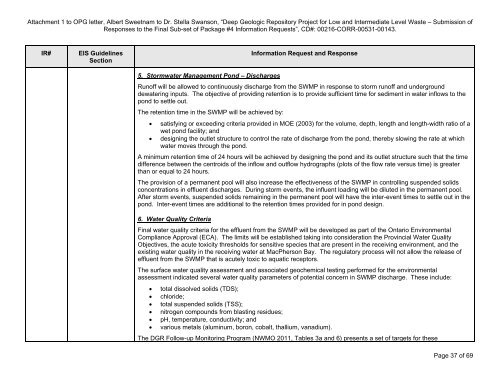Ontario Power Generation's Response to the Joint Review
Ontario Power Generation's Response to the Joint Review
Ontario Power Generation's Response to the Joint Review
You also want an ePaper? Increase the reach of your titles
YUMPU automatically turns print PDFs into web optimized ePapers that Google loves.
Attachment 1 <strong>to</strong> OPG letter, Albert Sweetnam <strong>to</strong> Dr. Stella Swanson, “Deep Geologic Reposi<strong>to</strong>ry Project for Low and Intermediate Level Waste – Submission of<br />
<strong>Response</strong>s <strong>to</strong> <strong>the</strong> Final Sub-set of Package #4 Information Requests”, CD#: 00216-CORR-00531-00143.<br />
IR# EIS Guidelines<br />
Section<br />
Information Request and <strong>Response</strong><br />
5. S<strong>to</strong>rmwater Management Pond – Discharges<br />
Runoff will be allowed <strong>to</strong> continuously discharge from <strong>the</strong> SWMP in response <strong>to</strong> s<strong>to</strong>rm runoff and underground<br />
dewatering inputs. The objective of providing retention is <strong>to</strong> provide sufficient time for sediment in water inflows <strong>to</strong> <strong>the</strong><br />
pond <strong>to</strong> settle out.<br />
The retention time in <strong>the</strong> SWMP will be achieved by:<br />
� satisfying or exceeding criteria provided in MOE (2003) for <strong>the</strong> volume, depth, length and length-width ratio of a<br />
wet pond facility; and<br />
� designing <strong>the</strong> outlet structure <strong>to</strong> control <strong>the</strong> rate of discharge from <strong>the</strong> pond, <strong>the</strong>reby slowing <strong>the</strong> rate at which<br />
water moves through <strong>the</strong> pond.<br />
A minimum retention time of 24 hours will be achieved by designing <strong>the</strong> pond and its outlet structure such that <strong>the</strong> time<br />
difference between <strong>the</strong> centroids of <strong>the</strong> inflow and outflow hydrographs (plots of <strong>the</strong> flow rate versus time) is greater<br />
than or equal <strong>to</strong> 24 hours.<br />
The provision of a permanent pool will also increase <strong>the</strong> effectiveness of <strong>the</strong> SWMP in controlling suspended solids<br />
concentrations in effluent discharges. During s<strong>to</strong>rm events, <strong>the</strong> influent loading will be diluted in <strong>the</strong> permanent pool.<br />
After s<strong>to</strong>rm events, suspended solids remaining in <strong>the</strong> permanent pool will have <strong>the</strong> inter-event times <strong>to</strong> settle out in <strong>the</strong><br />
pond. Inter-event times are additional <strong>to</strong> <strong>the</strong> retention times provided for in pond design.<br />
6. Water Quality Criteria<br />
Final water quality criteria for <strong>the</strong> effluent from <strong>the</strong> SWMP will be developed as part of <strong>the</strong> <strong>Ontario</strong> Environmental<br />
Compliance Approval (ECA). The limits will be established taking in<strong>to</strong> consideration <strong>the</strong> Provincial Water Quality<br />
Objectives, <strong>the</strong> acute <strong>to</strong>xicity thresholds for sensitive species that are present in <strong>the</strong> receiving environment, and <strong>the</strong><br />
existing water quality in <strong>the</strong> receiving water at MacPherson Bay. The regula<strong>to</strong>ry process will not allow <strong>the</strong> release of<br />
effluent from <strong>the</strong> SWMP that is acutely <strong>to</strong>xic <strong>to</strong> aquatic recep<strong>to</strong>rs.<br />
The surface water quality assessment and associated geochemical testing performed for <strong>the</strong> environmental<br />
assessment indicated several water quality parameters of potential concern in SWMP discharge. These include:<br />
� <strong>to</strong>tal dissolved solids (TDS);<br />
� chloride;<br />
� <strong>to</strong>tal suspended solids (TSS);<br />
� nitrogen compounds from blasting residues;<br />
� pH, temperature, conductivity; and<br />
� various metals (aluminum, boron, cobalt, thallium, vanadium).<br />
The DGR Follow-up Moni<strong>to</strong>ring Program (NWMO 2011, Tables 3a and 6) presents a set of targets for <strong>the</strong>se<br />
Page 37 of 69
















